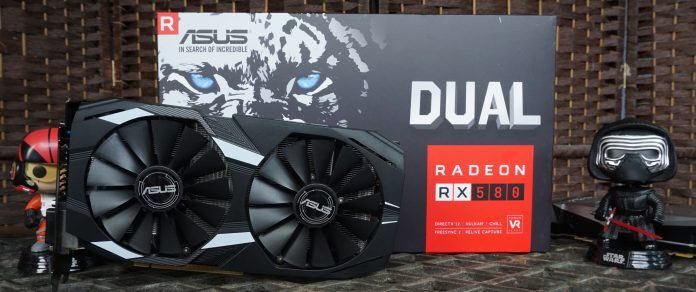ASUS RX 580 Dual OC 8GB review: The mainstream choice

AMD’s high-end Vega GPUs might be out and around the market, but they’re geared more to enthusiasts and high-end gamers. If you want something more modest for you gaming rig, the company still has some guns to offer, the RX 500 series.
The RX 500 series is basically an improved version of their previous RX 400 series. The latter using Polaris while the former uses the Polaris Refresh. In this particular review, we’ll be taking a look at the RX 580. Specifically, the ASUS RX 580 Dual OC 8GB. Before we get to it, let’s take a look at the specs of ASUS’ offering:
| ASUS Radeon RX 580 Dual OC 8GB | |
| Architecture | Polaris 10 |
| Manufacturing Process | 14nm |
| Stream Processors | 2304 |
| Texture Units | 144 |
| Raster Operations | 32 |
| Clock Speed | 1360MHz (Gaming Mode), 1380MHz (OC Mode) |
| Memory Clock | 8Gbps |
| Memory Bus Width | 256-bit |
| VRAM | 8GB GDDR5 |
| Transistor Count | 5.7 Billion |
Polaris Refresh
Courtesy of AMD.
Using their Polaris architecture from their RX 400 cards, the RX 500 GPUs uses a refreshed version of the Polaris. It offers higher clocks and memory speeds. The trade-off, however, is its higher TDP. Thus, leading to higher power consumption.
The Polaris refresh GPU uses AMD’s latest generation FinFET 14nm process, which is a fancy term for saying that the manufacturing process has matured enough that the chips that roll off the factory can now be pushed higher for better performance.
Aside from the better clocks speeds, AMD is using a new memory state to improve performance and efficiency of the memory. In essence, the RX 580 can now clock its memory to 4Gbps at a middle state, 1.2Gbps at idle, and 8Gbps on full load. This would lower is power consumption if the GPU is idle, and maximize performance whenever it’s on full load.
Courtesy of AMD.
The RX 500 series also takes advantage of AMD’s Radeon Chill, which was included with the Radeon Crimson Relive software. Radeon Chill saves power whenever it can during use. It dynamically regulates framerate based on your movements while in-game. Basically, it lowers the GPU capability if you’re in a safe and calm area but when the action starts and you need the extra frames, Radeon Chill will fully unleash the potential of your card.
Support for AMD’s FreeSync technology is supported by the RX 500 series. For those who are unfamiliar, it works just like NVIDIA’s GSync where tearing is avoided by syncing the refresh rate of the monitor to the number of frames put out by the GPU. As its name suggests, FreeSync is free to all manufacturers to implement in their displays. Currently, the only downside of FreeSync is its limited range of around 40fps to 90fps.
Up close with the ASUS RX 580 Dual OC 8GB
As is tradition in ASUS’ Dual series, the brand has replaced the blower-style cooler of the reference RX 580 and replaced it with a much beefier cooling solution. Its new cooler now boasts a two heatpipes with two wing-blade fans, which ASUS says deliver 105% more air pressure than the reference cooler. The cooler also sports the brand’s 0dB technology, so the fans don’t spin under 55 °C for a completely silent computing experience under light workload.
With a beefier cooler comes with light overclock with the ASUS RX 580 Dual OC 8GB. ASUS has increased the clock speed of the RX 580 by a small margin with the card able to attain 1360MHz under Gaming Mode and 1380MHz under OC Mode, which are 20 and 40MHz improvement over the stock Boost clock of 1340MHz, respectively.
Since the ASUS RX 580 Dual OC 8GB only has a relatively small overclock compared to the reference clocks, ASUS has stuck using a single 8-pin PCIe connector for its juice.
The card measures at 11.73 x 5.28 x 2.07-inches, which should fit most case types. ASUS has opted not to use a backplate to reduce the cost of the card. The reduce GPU sag, ASUS has employed a girder for extra support, an ingenious design choice from ASUS. Hopefully other mid-range and entry-level cards will use the same system.
The card isn’t part of the ROG lineup. Thus, RGB lighting isn’t supported by the ASUS RX 580 Dual OC 8GB. Sorry, RGB fanatics.
At the back is a fairly standard assortment of display connectors that include a Dual-Link DVI, two HDMI 2.0 ports, and two DisplayPort 2.0 connections.
System and Benchmarks
Currently, our in-house test bench is still on our pipeline. We used the following devices to test the ASUS RX 580 Dual OC 8GB:
- CPU: AMD Ryzen 5 1600X
- RAM: 16GB DDR4 RAM at 2400MHz, 14-16-16-16-19
- GPU ASUS RX 580 Dual OC 8GB
- Motherboard: ASRock Fatal1ty AB350 Gaming K4 (BIOS 3.00)
- PSU: EVGA GQ 650W 80+ Gold
- Cooler: Deep Cool Gammaxx 400
- OS: Windows 10 Build 1703
- Driver Version: AMD ReLive 17.8.2
As you can see on our benchmarks, the ASUS RX 580 Dual OC 8GB did not have any problems running our suite of games on 1080p with the highest settings. On 2560 x 1440, you may want to turn off demanding settings such as anti-aliasing to get better frame rates.
For temperature, the ASUS RX 580 Dual OC 8GB runs at idle at 32°C with the maximum temperature being 73°C. The fan curve was all handled by the video card itself. Based on our experience, we can barely hear the dual fans whirring away whenever we were stressing the card.
Conclusion
The RX 500 series might have been overshadowed by the release of Vega, but the RX 580 proves that it still have the power to take on the big boys at 1080p and even 1440p. You have two options with the ASUS RX 580 Dual OC 8GB, either play on 1080p with all settings turned up to the max or play at a higher 1440p while sacrificing overall fidelity.
It’s up to you if you want to sacrifice resolution or higher settings, but at a price of USD 279.99 (or PhP 18,880 in the Philippines) the ASUS RX 580 Dual OC 8GB is a decent card for gaming if you can find it in stock in stores.
 Accessible April 10 with the PlayStation Plus Game Catalog is a journey of Blue Prince’s shifting areas.
Accessible April 10 with the PlayStation Plus Game Catalog is a journey of Blue Prince’s shifting areas.  The PlayStation 4, Steam, and Xbox Series X|S release date for Marathon is September 23.
The PlayStation 4, Steam, and Xbox Series X|S release date for Marathon is September 23.  Bungie discusses its recovery FPS action in an interview with a marathon developer.
Bungie discusses its recovery FPS action in an interview with a marathon developer.  Trump grants wide-ranging tax deductions to Apple, giving them a huge break.
Trump grants wide-ranging tax deductions to Apple, giving them a huge break.  Legendary Quest on Apple TV + to come to an updated third season finale
Legendary Quest on Apple TV + to come to an updated third season finale  Amazon’s M4 MacBook Air price drops 24GB, 512GB standard to$ 1, 329
Amazon’s M4 MacBook Air price drops 24GB, 512GB standard to$ 1, 329